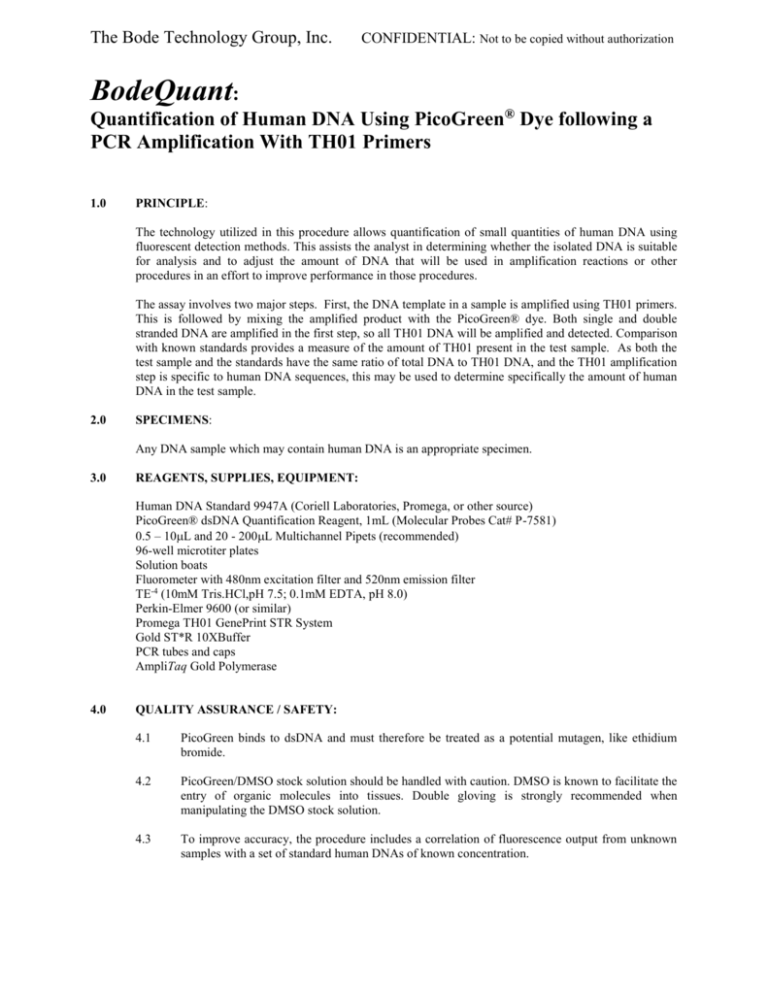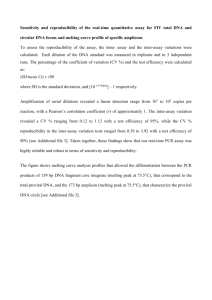BodeQuant: - Bode Technology Group, Inc.
advertisement

The Bode Technology Group, Inc. CONFIDENTIAL: Not to be copied without authorization BodeQuant: Quantification of Human DNA Using PicoGreen® Dye following a PCR Amplification With TH01 Primers 1.0 PRINCIPLE: The technology utilized in this procedure allows quantification of small quantities of human DNA using fluorescent detection methods. This assists the analyst in determining whether the isolated DNA is suitable for analysis and to adjust the amount of DNA that will be used in amplification reactions or other procedures in an effort to improve performance in those procedures. The assay involves two major steps. First, the DNA template in a sample is amplified using TH01 primers. This is followed by mixing the amplified product with the PicoGreen® dye. Both single and double stranded DNA are amplified in the first step, so all TH01 DNA will be amplified and detected. Comparison with known standards provides a measure of the amount of TH01 present in the test sample. As both the test sample and the standards have the same ratio of total DNA to TH01 DNA, and the TH01 amplification step is specific to human DNA sequences, this may be used to determine specifically the amount of human DNA in the test sample. 2.0 SPECIMENS: Any DNA sample which may contain human DNA is an appropriate specimen. 3.0 REAGENTS, SUPPLIES, EQUIPMENT: Human DNA Standard 9947A (Coriell Laboratories, Promega, or other source) PicoGreen® dsDNA Quantification Reagent, 1mL (Molecular Probes Cat# P-7581) 0.5 – 10L and 20 - 200L Multichannel Pipets (recommended) 96-well microtiter plates Solution boats Fluorometer with 480nm excitation filter and 520nm emission filter TE-4 (10mM Tris.HCl,pH 7.5; 0.1mM EDTA, pH 8.0) Perkin-Elmer 9600 (or similar) Promega TH01 GenePrint STR System Gold ST*R 10XBuffer PCR tubes and caps AmpliTaq Gold Polymerase 4.0 QUALITY ASSURANCE / SAFETY: 4.1 PicoGreen binds to dsDNA and must therefore be treated as a potential mutagen, like ethidium bromide. 4.2 PicoGreen/DMSO stock solution should be handled with caution. DMSO is known to facilitate the entry of organic molecules into tissues. Double gloving is strongly recommended when manipulating the DMSO stock solution. 4.3 To improve accuracy, the procedure includes a correlation of fluorescence output from unknown samples with a set of standard human DNAs of known concentration. The Bode Technology Group, Inc. 5.0 CONFIDENTIAL: Not to be copied without authorization PROCEDURE: 5.1 Preparation of Reagents. 5.1.1 Preparation of PCR Reaction Mix For each PCR reaction, use 0.75L 10 X TH01 Primers, 2.5L 10 X GoldST*R Buffer, 20.6L ddH2O and 0.15L AmpliTaq Gold Polymerase (assuming 5U/L enzyme stock). Multiply these volumes by the number of samples plus 13 (to accommodate the 12 DNA standards and a little extra) to make a pooled reaction mix. NOTE: Add polymerase last, immediately before mixing and aliquoting the reaction mix to PCR tubes. 5.1.2 Preparation of DNA Standards Prepare DNA standards for the standard curve. (The range and concentration of standards used may be varied by the analyst, if desired, without compromising the assay. Those described here are suggested for general use.) First prepare a 40ng/L solution of 9947A DNA by appropriate dilution of the commercially prepared material into a TE -4 solution. Then create 20ng/L, 10ng/L, 7ng/L, 4ng/L, 2ng/L, 1ng/L, 0.7ng/L, 0.4ng/L, 0.2ng/L, 0.1ng/L, and 0ng/L solutions by dilution of the 40ng/L solution into the appropriate volumes of TE -4. Do not use less than 2L of the 40ng/L solution in any preparation. This limits variations from the use of small volumes. Note: Numerous freeze-thaws of the standard DNA produce erratic results. It is suggested that multiple tubes of the standard reagent be prepared on the first thaw. 5.1.3 Preparation of PicoGreen Reagent NOTE: Approximately 24ml TE-4 Buffer is needed for all steps for each full 96-well assay. Prepare PicoGreen dsDNA quantification reagent. Approximately 2.5ml of the diluted reagent is needed in a 96-well assay. Mix 12.5L concentrated PicoGreen/DMSO solution (commercially prepared component) with 2.5ml TE-4 Buffer. The total volume of components may be scaled up or down in a 1:200 ratio as needed. NOTE: The supplier advises preparation of the PicoGreen dsDNA quantification reagent in a plastic rather than a glass container, as the reagent may be absorbed into glass surfaces. A diluted solution, wrapped in foil and stored in a refrigerator, may be stored for at least two weeks. 5.2 Amplification of sample and standard materials 5.2.1 Add 24L of PCR reaction mix (prepared as above) to each PCR tube to be used for standards or samples. 5.2.2 Add 1L of each of the pre-made 9947A human DNA standards (40ng/L to 0ng/L) to PCR tubes in row A of a PCR tray in positions 1-12, respectively. 5.2.3 Add 1L of unknown DNA to each of the remaining wells (a full tray is not required for the assay). Unknown DNA may be diluted to the analyst’s preference before adding to the PCR tube. The Bode Technology Group, Inc. 5.2.4 CONFIDENTIAL: Not to be copied without authorization Cap PCR tubes and place on PE 9600 (or similar) thermal cycler. Run the thermal cycler with the following parameters: Cycling Conditions: 95°C X 11 minutes 96°C X 1 minute 0 ramp, 94°C X 30 seconds 1.08 ramp, 60°C X 30 seconds 0.50 ramp, 70°C X 45 seconds (10 cycles) 0 ramp, 90°C X 30 seconds 1.00 ramp, 60°C X 30 seconds 0.50 ramp, 70°C X 45 seconds (20 cycles) 60°C Hold X 30 minutes 4°C Hold 5.2.5 After the thermal cycler run, amplicons may be quantitated immediately or stored in a freezer at 20°C until the analyst is ready to perform the remainder of the assay. 5.3 PicoGreen quantification of amplified materials 5.3.1 Turn on the Cytofluor 4000 Multi-Well Plate Reader and make sure the lamp is on. The lamp should warm up for a minimum of 10 minutes prior to the running of the assay. 5.3.2 Add 98L of TE-4 to each assay well of a 96-well tray. 5.3.3 Add 2L of amplicon from standards and unknowns to corresponding wells of the 96-well tray. 5.3.4 In a plastic container (e.g., 15mL conical tube), mix 2.2mL of PicoGreen/DMSO solution, from 5.1.3 above, with 8.8mL of TE-4. If less than a full tray is used, scale the volume down proportionately. 5.3.5 Using a multi-channel pipette, add 100L of the PicoGreen/DMSO/TE-4 solution made in step 5.3.4 to each well. Mix thoroughly with the sample or control materials already present. 5.3.6 Let stand at room temperature for approximately 5 min. 5.3.7 Place the microtiter plate into a PerSeptive Biosystems Cytofluor 4000 Multi-Well Plate Reader. Make sure the correct 96-well plate brand is selected. Run the assay with a gain of 80. (The analyst may adjust the gain setting as needed.) 5.3.7 Save data as a *.mrf file. 5.3.8 Export the data into EXCEL. 5.4 Interpretation of results 5.4.1 Plot a graph of Arbitrary Fluorescence Units (AFUs) versus known 9947A DNA standards. Compare and extrapolate the value for each unknown sample using the standard curve. An EXCEL spreadsheet has been created to assist with graphing and extrapolation. The current version is called "BodeQuant Version 010307". This or derivatives of this file may be used. 1) Copy the microtiter dish format output of the fluorometer into the designated space of the Human Quant file. The Bode Technology Group, Inc. CONFIDENTIAL: Not to be copied without authorization 2) Two graphs will be updated. Trendlines are created for curves based on 20ng and 40ng maximum input DNA. Copy all four coefficients from the equations shown on each graph into the designated spaces above the graphs. 3) Calculated DNA concentrations for each standard and test DNA sample can be read in the boxed table, below the graphs.








